
Lesson Thirteen: Cities and Hinterlands: The Modern Northwest
Landmarks and a city view of Portland, 1858 (right).
Oregon dominated the early American Northwest because most of the newcomers to the region went there. By far the majority of them were attracted by the farmland, particularly in the Willamette Valley. They migrated to the country while relying on family and community networks of communication and support, and once in Oregon they tended to settle in clusters that kept family and community together. As discussed in Lesson 9, most of these rural households operated at some remove from the national market system. They wanted to sell their surplus crops to buyers, but tended to concern themselves with their own subsistence first. They also developed a distinctive politics that saw virtue in family men who owned a limited amount of landed property—"small freeholders"—rather than in the wealthy, mercantile, or working classes. These initial American settlers long remained influential in Oregon. Indeed, they helped to create a culture and a society that many believe helps to explain Oregon distinctiveness to this day.
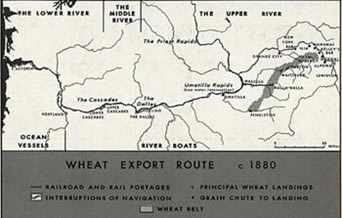
At the same time, however, another type of economic and social development was emerging in the town of Portland and around Puget Sound. Portland quickly became the leading city of the Pacific Northwest.
Situated at the confluence of the Columbia and Willamette rivers, and used as a port by ocean-going vessels, its location and enterprise made it the leading commercial center north of San Francisco. Farm products from the Willamette Valley, minerals from Idaho, and wheat from around Walla Walla all flowed to market by way of Portland. While Portland grew, San Francisco capitalists discovered the forests on Puget Sound. California mines, cities, and ships required prodigious amounts of lumber, and the deep waters and forested shorelines of Puget Sound offered the most convenient place to get that commodity. At Seattle and Port Gamble and Port Ludlow and a host of other sites around the Sound, docks and sawmills appeared to deliver wood products to the ships that sailed away to San Francisco and other Pacific ports. Around Puget Sound and in Portland during the 1850s and after, one can detect the emergence of an urban and industrial economy that would eventually surpass and engulf the farm economy started in the Willamette Valley. The rural economy and society were more traditional and, being so strongly associated with pioneers, became the focus of much attention Over the long term, however, the urban and industrial economy and society were much more influential in the Pacific Northwest, forming the basis for the modern region. These will be our focus for the remainder of the course.
Map of wheat export route, c.1880 (above left). (D. W. Meinig, Great Columbia Plain. Seattle, 1968. 252.) Columbia River sternwheelers (below right) were one means of transporting the wheat from the Walla Walla Valley to Portland. This view shows one passing through the Cascade Locks prior to the construction of the Bonneville Dam at this location. (Special Collections, University of Washington, Postcard Files. Photo by Cross and Dimmitt.)
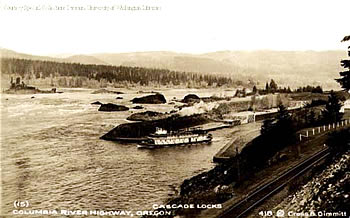
Here I want to describe the spatial organization of the urban and industrial Northwest during the 19th century, and in particular I wish to develop the idea of metropolis and hinterland. As part of the North American West generally, the Pacific Northwest was divided into a series of subregions or hinterlands, each of which produced extractive commodities that moved to market by way of a hierarchical series of towns and cities. For example, the Walla Walla Valley of southeastern Washington became known as farming country during the 1850s and 1860s. Grain grown there was gathered in towns like Walla Walla, which served as points of export and import for the surrounding farms. From Walla Walla, the grain was shipped to the Columbia and then downstream to Portland on river-going vessels. The Walla Walla Valley, and indeed virtually all of western Idaho, eastern Oregon and Washington, and the Willamette Valley, were hinterlands for Portland—the metropolis or leading city. That is, the goods they produced made their way to market by way of Portland; goods they imported from around the world made their way to these hinterlands by way of Portland; and Portland also served as the chief financial and retail center for these regions as well. At Portland, furthermore, goods moving up and down the Columbia River system were transferred to different sorts of vessels for the next stage of their trip. Walla Walla wheat, for example, was there put aboard ocean-going vessels for shipment to other ports, most likely San Francisco. San Francisco was the leading city of the entire Far West, and the Pacific Northwest—including Alaska as well as British Columbia through the 1880s—was its hinterland. Within the Northwest, Portland played the role that San Francisco played for the entire North American West. That role was largely economic—based on its command over commerce—but it was also cultural, as Portland initially hosted the region's leading cultural institutions, e.g. churches and newspapers.

Spokane in 1909. Stevens Street looking south from Main Avenue, left. (Special Collections, UW. Dennison Photo taken for the Spokane Chronicle. UW negative #5344.)
Put another way, the region came to be organized around a host of towns and cities such as Portland, Victoria, Tacoma, Seattle, Spokane, and Boise. The power of each city was commensurate with the extent and wealth of its hinterland. Each town prospered as the interior region that it served, and that relied upon it, prospered. And these interiors were creations of systems of transportation. While many of the pioneer settlers of the Willamette Valley did not so much mind isolation, the majority of Euro-Americans in the region wanted to be linked up to the global market economy.So long as river travel remained the cheapest method of transportation, the city that dominated that traffic would dominate the Northwest. Thus the city of Portland, commanding the Columbia River watershed through its location at the junction of the main stem of the Columbia and the Willamette, remained the premier city of the region into the 20th century.

Beginning in the 1880s, however, the arrival of railroads in the region began to undermine Portland's predominance. Portland depended upon the natural transport system of rivers to bring produce and profits to it. Railroads, on the other hand, were a man-made transport system that provided an alternative to river travel. Once railway lines were completed to and through the Pacific Northwest, other cities capitalized on them to carve out their own hinterlands separate from Portland's control. Thus in the 1880s and 1890s the cities of Tacoma, Vancouver, B.C., and Seattle began to chip away at Portland's leadership on the Pacific coast, while Spokane emerged as the metropolis for what was called the "Inland Empire." As the following charts show, the arrival of the railroads also stimulated an enormous population boom, both in cities and throughout the region, beginning in the 1880s.
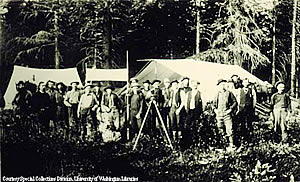
Tacoma (above right), the terminus of the Northern Pacific Railroad, in 1878. (Lithograph after a drawing by E.S. Grover. Stokes Collection, New York Public Library.)
Camp of Northern Pacific Railroad engineers (left) in the Cascade Mountains in 1886 during the construction of the Stampede Tunnel, below left. Up until this time the Northern Pacific transcontinental line, completed in 1883, ran through Portland. With the completion of the Cascade line into Tacoma--and later Seattle--trains could by-pass Portland and wheat, as well as other freight, was shipped directly to Puget Sound ports. (Special Collections, University of Washington. UW negative #5815.)
|
|
||||||||||||||||||||||||||||||||||||||||||||||||||||||||||||||||||||||||||||||||||||||||||||||||
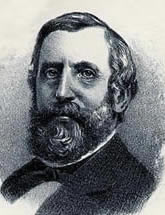
William S. Ladd was one of the many leaders of Portland during the city's early years. He was one individual, however, who did not restrict his investments to the Oregon city. At the time of his death in the 1890s he owned considerable property, in addition to controlling interest in transportation and industrial companies, throughout Washington State. (Special Collections, University of Washington. UW negative #17579.)
Portland's success was not due entirely to its fortunate location. It also benefited from astute leaders who secured the city's future in a host of ways. The city had a number of rival towns nearby, but it surpassed them when prominent businessmen established an efficient steamship service to and from San Francisco; launched the successful Oregonian newspaper to promote the town; and built a road to the west to serve the productive wheat farms there. On such foundations, Portland became the headquarters for trade and transportation throughout the Willamette River Valley, the most densely populated part of the region. When the Gold Rush in California generated a tremendous demand for foodstuffs, lumber, and other products, Portland stood ready to service that demand by shipping goods from its hinterlands, and throughout the 1850s it began to prosper. Throughout this era, Portland's conservative business leadership became well known. One west coast judge commented on the city's staid and sensible nature in 1868: "Portland will never be the centre of fashion, speculation, or thought. Do what it will, it will be a comparatively provincial place...but it will be worth more dollars per head than either London or New York, and its good citizens will sleep sounder and live longer than the San Franciscans." Once again, contrasting Oregon to California seemed to come naturally.
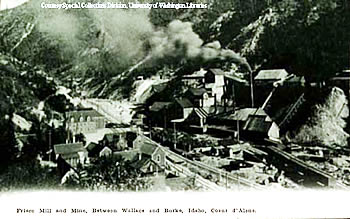
Frisco Mill and Mine located between Wallace and Burke, Idaho in the Coeur d'Alene mining region. (Special Collections, University of Washington, Postcard Files. Inland Printing Company, Spokane.)
As extractive industries in the interior of the Pacific Northwest developed, Portland strengthened its leadership as the financial, commercial, and transportation center. For example, in the early 1860s prospectors struck gold and silver in Idaho, creating a rush to such places as the Clearwater and Boise river valleys. Portland serviced these mines, sending them supplies as well as more people and exporting the minerals from them. By 1861, Idaho mines exported $400,000 worth of minerals per month via of Portland— virtually all by way of the same shipping company. Beginning in 1860, Portland's power as a metropolis increased with the formation of the Oregon Steam Navigation Company (OSNC). This firm secured Portland's control over the Columbia River watershed by establishing a monopoly on cargo traffic up and down the Columbia River. It did so by buying and controlling the key river portages at The Dalles and Cascades—places where goods had to be shipped overland to get around river rapids. Towns along Puget Sound in Washington Territory tried to destroy the monopoly, which they regarded as their main impediment to receiving more cargo traffic and overland migrants themselves, but the OSNC easily turned that challenge away. Indeed it endured until the 1880s, when it became the Oregon Railway and Navigation Company, merging its river transport network to the growing transcontinental railroads in an effort to maintain its monopoly and Portland's leadership position.
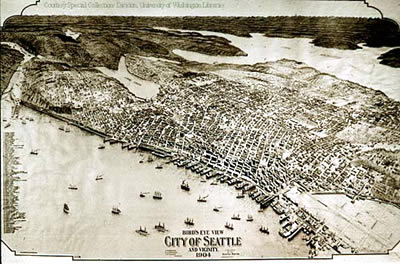
Aerial view of Seattle in 1904 (right).
As the leading city in the Northwest, Portland was certain to be linked up to transcontinental lines once they arrived in the 1880s. However, these lines ultimately undermined the city's leadership position. Its primacy had stemmed from its location near the mouths of the Columbia and Willamette rivers, where it could command the flow of almost all the products and passengers moving into and out of the region. But railroads offered an alternative to river travel that challenged Portland's "natural" advantage. They enabled cargoes and passengers to bypass the city. Moreover, they enabled cargoes and passengers to bypass one of the main disadvantages of river travel—the dangerous bar where the Columbia meets the Pacific Ocean. Between 1883 and 1893, cities to the north of Portland, on the safer, deep-water harbors of Puget Sound and the Straits of Georgia, acquired their own connections to transcontinental railroads—and by railroads to interior regions of the Northwest as well as to eastern North America. Railways served as man-made rivers, directing traffic to Tacoma, Seattle, Everett, and Vancouver, B.C. in the same way that the Columbia had funneled traffic through Portland. Cities on the Straits and Sound expanded their own hinterlands; exported some extractive products (such as coal, timber, and fish) more readily than Portland could; and hustled by a variety of methods to steal away some of Portland's (and San Francisco's) business. The most successful rival was Seattle, which captured Alaska and the Yukon as a hinterland after 1893, and then surpassed Portland in size by 1910.
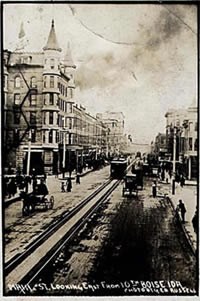
Boise, Idaho. Main Street looking east from 10th, c. 1913. (Special Collections, University of Washington, Postcard Files. Photo by G. Ed. Russell.)
As the leading city in the Northwest, Portland was certain to be linked up to transcontinental lines once they arrived in the 1880s. However, these lines ultimately undermined the city's leadership position. Its primacy had stemmed from its location near the mouths of the Columbia and Willamette rivers, where it could command the flow of almost all the products and passengers moving into and out of the region. But railroads offered an alternative to river travel that challenged Portland's "natural" advantage. They enabled cargoes and passengers to bypass the city. Moreover, they enabled cargoes and passengers to bypass one of the main disadvantages of river travel—the dangerous bar where the Columbia meets the Pacific Ocean. Between 1883 and 1893, cities to the north of Portland, on the safer, deep-water harbors of Puget Sound and the Straits of Georgia, acquired their own connections to transcontinental railroads—and by railroads to interior regions of the Northwest as well as to eastern North America. Railways served as man-made rivers, directing traffic to Tacoma, Seattle, Everett, and Vancouver, B.C. in the same way that the Columbia had funneled traffic through Portland. Cities on the Straits and Sound expanded their own hinterlands; exported some extractive products (such as coal, timber, and fish) more readily than Portland could; and hustled by a variety of methods to steal away some of Portland's (and San Francisco's) business. The most successful rival was Seattle, which captured Alaska and the Yukon as a hinterland after 1893, and then surpassed Portland in size by 1910.
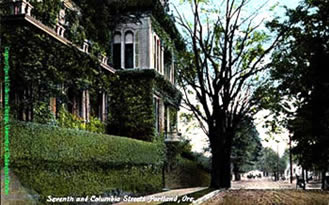
Although Portland would no longer be the biggest city of the region, it long remained the most refined. From the start, founders of the city had aspired to imitate eastern cities; indeed, the city's name had been determined by a coin flip between a Massachusetts man (who wanted "Boston") and a Maine native (who won). There was an impulse to create in Portland another version of the New England town, and the city soon acquired an ample number of churches, schools, fine homes, and business blocks. It had a more reputable newspaper, livelier theatrical and musical scenes, and an urbane quality that many easterners noted with admiration. One of them—Samuel Bowles—remarked in 1869: "Oregonians have builded what they have got more slowly and more wisely than the Californians; they have less...to unlearn; and they seem sure, not of organizing the first state on the Pacific coast, indeed, but of a steadily prosperous, healthy, and more one—they are in the way to be the New England of the Pacific Coast." Nobody, it must be noted, gave similar praise to Seattle in this period.
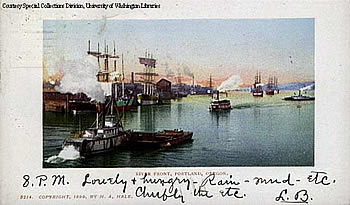 A residential neighborhood in Portland (above), on Seventh and Columbia Streets. (Special Collections, University of Washington, Postcard Files. Published by M. Rieder, Los Angeles.)
A residential neighborhood in Portland (above), on Seventh and Columbia Streets. (Special Collections, University of Washington, Postcard Files. Published by M. Rieder, Los Angeles.)
River Front, Portland in 1899 (left). (Special Collections, University of Washington Libraries, Postcard Files. Photo by H. A. Hale.)
Perhaps Portland's only drawback was the weather, which one visitor noted in 1865:
Rain is an exceedingly pleasant and gratifying institution in its way, and in moderation; it causes the grass to grow, the blossoms to flourish, and it is a positive necessity to the umbrella-maker; but when you get to a country where it rains incessantly twenty-six hours a day, for seventeen months in the year, you cannot resist having the conviction forced upon your mind that the thing is slightly overdone. That's the case in Oregon; it commenced raining pretty heavily on the third of last November, and continued up to the fifteenth of May, when it set in for a long storm, which isn't fairly over yet. There's moisture for you.
The consequences of this awful climate are just what might be supposed. The immense quantity of the protoxide squirted about here causes trees, buildings, streets, everything, to present a diluted and wishy-washy appearance. The women lose their color, the men their hair (washed off, sir), and the animals, by constant exposure, acquire scales and fins, like the natives of the great deep. In fact, all the inhabitants of this territory have a generally scaly appearance, and rejoice in a peculiar smell, a combination, I should say, of a fishball and a fresh mud-sucker....
The visitor allowed that Oregon presented travelers with many amusing things, yet he also found it difficult to laugh about them while in the state: "Such a thing as 'dry' humor in Oregon is, of course, a physical impossibility."
| Course Home | Previous Lesson | Next Lesson |